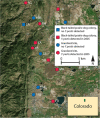No evidence for enzootic plague within black-tailed prairie dog (Cynomys ludovicianus) populations
- PMID: 33882192
- PMCID: PMC9292313
- DOI: 10.1111/1749-4877.12546
No evidence for enzootic plague within black-tailed prairie dog (Cynomys ludovicianus) populations
Abstract
Yersinia pestis, causative agent of plague, occurs throughout the western United States in rodent populations and periodically causes epizootics in susceptible species, including black-tailed prairie dogs (Cynomys ludovicianus). How Y. pestis persists long-term in the environment between these epizootics is poorly understood but multiple mechanisms have been proposed, including, among others, a separate enzootic transmission cycle that maintains Y. pestis without involvement of epizootic hosts and persistence of Y. pestis within epizootic host populations without causing high mortality within those populations. We live-trapped and collected fleas from black-tailed prairie dogs and other mammal species from sites with and without black-tailed prairie dogs in 2004 and 2005 and tested all fleas for presence of Y. pestis. Y. pestis was not detected in 2126 fleas collected in 2004 but was detected in 294 fleas collected from multiple sites in 2005, before and during a widespread epizootic that drastically reduced black-tailed prairie dog populations in the affected colonies. Temporal and spatial patterns of Y. pestis occurrence in fleas and genotyping of Y. pestis present in some infected fleas suggest Y. pestis was introduced multiple times from sources outside the study area and once introduced, was dispersed between several sites. We conclude Y. pestis likely was not present in these black-tailed prairie dog colonies prior to epizootic activity in these colonies. Although we did not identify likely enzootic hosts, we found evidence that deer mice (Peromyscus maniculatus) may serve as bridging hosts for Y. pestis between unknown enzootic hosts and black-tailed prairie dogs.
Keywords: Cynomys ludovicianus; Yersinia pestis; black-tailed prairie dog; plague; prairie dogs.
© 2021 International Society of Zoological Sciences, Institute of Zoology/Chinese Academy of Sciences and John Wiley & Sons Australia, Ltd.
Figures



Similar articles
-
Plague-Positive Mouse Fleas on Mice Before Plague Induced Die-Offs in Black-Tailed and White-Tailed Prairie Dogs.Vector Borne Zoonotic Dis. 2019 Jul;19(7):486-493. doi: 10.1089/vbz.2018.2322. Epub 2019 Apr 17. Vector Borne Zoonotic Dis. 2019. PMID: 30994405
-
Detection of Yersinia pestis DNA in prairie dog-associated fleas by polymerase chain reaction assay of purified DNA.J Wildl Dis. 2010 Apr;46(2):636-43. doi: 10.7589/0090-3558-46.2.636. J Wildl Dis. 2010. PMID: 20688665
-
Oropsylla hirsuta (Siphonaptera: Ceratophyllidae) can support plague epizootics in black-tailed prairie dogs (Cynomys ludovicianus) by early-phase transmission of Yersinia pestis.Vector Borne Zoonotic Dis. 2008 Jun;8(3):359-67. doi: 10.1089/vbz.2007.0181. Vector Borne Zoonotic Dis. 2008. PMID: 18454591
-
Evaluation of Yersinia pestis Transmission Pathways for Sylvatic Plague in Prairie Dog Populations in the Western U.S.Ecohealth. 2016 Jun;13(2):415-27. doi: 10.1007/s10393-016-1133-9. Epub 2016 May 27. Ecohealth. 2016. PMID: 27234457 Review.
-
The Role of Early-Phase Transmission in the Spread of Yersinia pestis.J Med Entomol. 2015 Nov;52(6):1183-92. doi: 10.1093/jme/tjv128. Epub 2015 Aug 19. J Med Entomol. 2015. PMID: 26336267 Free PMC article. Review.
Cited by
-
Exploring and Mitigating Plague for One Health Purposes.Curr Trop Med Rep. 2022;9(4):169-184. doi: 10.1007/s40475-022-00265-6. Curr Trop Med Rep. 2022. PMID: 39210935 Free PMC article.
-
Rapid adaptation to a globally introduced virulent pathogen in a keystone species.PNAS Nexus. 2025 Jul 8;4(7):pgaf199. doi: 10.1093/pnasnexus/pgaf199. eCollection 2025 Jul. PNAS Nexus. 2025. PMID: 40630918 Free PMC article.
-
Plague risk in the western United States over seven decades of environmental change.Glob Chang Biol. 2022 Feb;28(3):753-769. doi: 10.1111/gcb.15966. Epub 2021 Nov 18. Glob Chang Biol. 2022. PMID: 34796590 Free PMC article.
-
Development and evaluation of a multi-target droplet digital PCR assay for highly sensitive and specific detection of Yersinia pestis.PLoS Negl Trop Dis. 2024 May 3;18(5):e0012167. doi: 10.1371/journal.pntd.0012167. eCollection 2024 May. PLoS Negl Trop Dis. 2024. PMID: 38701065 Free PMC article.
-
Reevaluation of the Role of Blocked Oropsylla hirsuta Prairie Dog Fleas (Siphonaptera: Ceratophyllidae) in Yersinia pestis (Enterobacterales: Enterobacteriaceae) Transmission.J Med Entomol. 2022 May 11;59(3):1053-1059. doi: 10.1093/jme/tjac021. J Med Entomol. 2022. PMID: 35380675 Free PMC article.
References
-
- Allender CJ, Easterday WR, Van Ert MN, Wagner DM, Keim P (2004). High‐throughput extraction of arthropod vector and pathogen DNA using bead milling. Biotechniques 37, 730–4. - PubMed
-
- Ayyadurai S, Houhamdi L, Lepidi H, Nappez C, Raoult D, Drancourt M (2008). Long‐term persistence of virulent Yersinia pestis in soil. Microbiology (Reading, England) 154, 2865–71. - PubMed
-
- Bacon M, Drake CH (1958). Comparative susceptibility of various species of mice native to Washington to inoculation with virulent strains of Pasteurella pestis . Journal of Infectious Diseases 102, 14–22. - PubMed
MeSH terms
Grants and funding
- DEB-0224328/NSF/NIH joint program in Ecology of Infectious Diseases
- R15 AI070183/AI/NIAID NIH HHS/United States
- R-82909101-0/National Center for Environmental Research (NCER) STAR program of the US-EPA
- U54 AI065359/AI/NIAID NIH HHS/United States
- AI065359/Pacific-Southwest Regional Center of Excellence
LinkOut - more resources
Full Text Sources
Other Literature Sources
Medical

